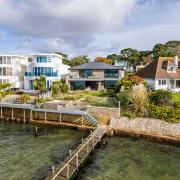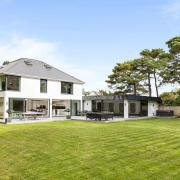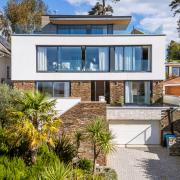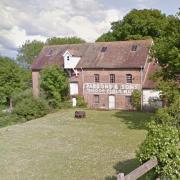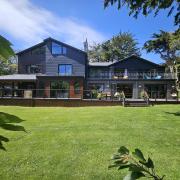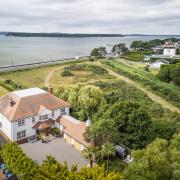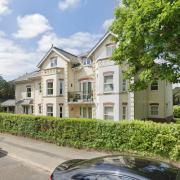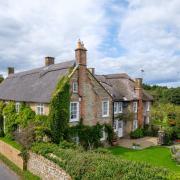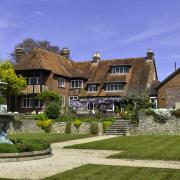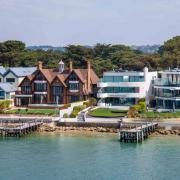I know Lulworth well. At least I thought I did. Every Sunday, I drive past the Estate wall on my way to swim at Lulworth Cove. I’ve often glimpsed the castellated towers of Lulworth Castle set within rolling parkland. However, it wasn’t until I came across Lulworth Castle House listed on the National Garden Scheme website that I realised there was a garden there.
It's a warm July morning and I’m on my way to meet Sara Weld who, along with her husband James, owns and manages the 12,000-acre Lulworth Estate on the Isle of Purbeck. The Weld family are custodians of two famous Dorset landmarks - Durdle Door and Lulworth Cove – as well as the magnificent 17th century Lulworth Castle which hosts the family-friendly Camp Bestival in its grounds every July. But I’m here to explore a very private and unique garden, one seldom seen by the public, which Sara has crafted and nurtured at her home, Lulworth Castle House.

Since 1641, Lulworth Castle had been the ancestral home of this Dorset family, until a catastrophic fire in 1929 left it completely uninhabitable. Lulworth Castle House, completed in 1977 by James’s parents, Wilfrid and Sally, re-established the Weld family seat within the Castle Park. This is where James and Sara have brought up their three sons, now all grown-ups. So, I can’t wait to see whether its garden mirrors this newer stately home.
I’m met by Sara and her black Labrador at the front of the house. Straight away, Sara is full of infectious enthusiasm for her garden, much of which she has designed from scratch with the help of her gardening team. At the back of the house, we step onto a neatly trimmed lawn with a pool of dark blue water beyond. I’m reminded of a conversation I had with Alison Wright, South West Regional Chairman and Dorset County Organiser of the National Gardens Scheme. ‘It’s my favourite garden in Dorset,’ she told me, and I can already see why. As the various tones of blue from the pool, sky, and sea (just visible at Arish Mell Cove) merge with the greens of the grass, trees, and distant hills, I’m left speechless.

As we continue the tour, I realise this is a garden made up of intriguing rooms. And, just like a box of assorted chocolates, I’m not sure what delights I will encounter next. Leaving the Square Pool, we walk beneath an arch and enter the Pool Garden. This space has a softer almost romantic tempo. The froth from an herbaceous border, awash with pink roses and acid green euphorbia, flops over a gravel path. On a pergola, pink and white roses flow like a waterfall from weathered-wood columns.

Running with this unstructured theme, we follow a mown path that winds its way through an old orchard. Here, the stunted branches of the fruit trees remind me of weathered fishermen, lichen covered and knee-deep in a sea of grass. In the distance, I spot a small blue wooden building with a tiled roof and white-painted window frames. ‘That’s the ticket hut from the old Hampshire County Cricket ground,’ Sara says, laughing, as she goes on to explain how they had to crane it over the old garden wall. ‘It was quite a nerve-wracking experience. Now it’s used as a tennis pavilion.’ It’s these delightful personal touches that add a certain quirky charm to this large garden.

Through a gate, and now we’re in the Productive Garden. Here clipped parterres are reminiscent of the ornamental vegetable gardens found in the grand chateaux of the Loire in France, except here they are smaller and more manageable. A warm red brick wall encloses one side of the garden, smothered in a wisteria, thought to be hundreds of years old. It must look and smell breathtaking when in bloom. We walk past poppies, their seed heads ready to burst, and dark-stemmed yellow and red-flowering dahlia peeping over the clipped hedges, towards a handsome white wooden greenhouse. Next to it, a weathered metal-framed fruit cage which almost echoes the greenhouse’s design. ‘The fruit cage was made by a man who has a workshop in the village,’ Sara explains, ‘The design was taken from an old book on garden buildings.’ It’s clear that Sara has meticulously planned and researched every aspect of the garden’s structure and design, from flower bed to fruit cage.

As we amble along the Scented Walk, a bronze nymph sculpture by David Williams-Ellis, affectionately known as Kya, points the way towards the next gate. The mood shifts again in this ‘room’. The only formality here is the clipped boundary hedges; a mown path meanders through a kaleidoscope of wildflowers abuzz with insects foraging for nectar.

This sense of calm and tranquillity continues as we enter the Lavender Labyrinth. Lavender plants swirl around a central gazebo swathed in roses, and, as I brush my hands against lavender spikes, their heady scent lingers in the warm air. ‘The other night when I was picking lavender, there was at least one bee on every plant. At roughly 960 lavenders, that makes nearly 1000 bees,’ says Sara, as she tells me about the new Wild White Garden, Foragers Garden and observational bee hut they are installing this year.
It’s clear that gardening in harmony with nature is something Sara is eager to do more of. Across the whole estate the Weld family endeavour to maintain and improve the widest possible variety of habitats to maximise the flora and fauna found here. And they are succeeding as they have more than 60% of British butterflies here, including the Lulworth Skipper.

Finally, we enter what Sara tells me is the final ‘garden room’. She has saved the best for last. Stretching away in front of us is a straight rill of tranquil water flanked on either side by light coloured stone walkways. At the mid-way point, a large bowl set on a plinth of blue and green Moroccan tiles meets two other rills at right angles. This is the Persian-inspired Charbagh Garden, a contemplative, cool and soothing space. Its ancient design features a quadrilateral garden divided by water channels - Charburgh means ‘four gardens’. Sara disappears to turn on a tap, within seconds jets of water are dancing across the fountains and the rills are gurgling and bubbling. Then I watch, rather amused, as Sara hastily runs up and down the rills, poking a stick into the heads of each spout to unblock the ones that aren’t working. Even in paradise limescale buildup is inevitable.
After spending several fascinating hours with Sara in the gardens of Lulworth Castle House, it is with great reluctance that I make my goodbyes. The garden not only reflects Sara’s exceptional gardening skills but also her thoughtful approach to garden design. She took what was an empty canvas and planted within it her distinctive ideas, embracing influences from her personal experiences and the world around her, both the past and the present. It is also the story of the Weld family, rooted in over 300 years of history at Lulworth, and at one with the landscape they continue to nurture for future generations.
Lulworth Castle House Gardens are not open to the public, but they are open ‘by arrangement’ for a special NGS event every year

Sara Weld’s Summer Flowering Favourites
Salvia ‘Amistad’: Bushy, upright perennial, up to 1.2m. Corrugated, bright green slender leaves. Large, deep purple tubular flowers from early summer to first frosts.
Erysium ‘Bowles Mauve’: Bushy, evergreen perennial wallflower, up to 75cm. Narrow, grey-green leaves. Mauve blooms that flower over a long period.
‘Darcey Bussell’: Compact shrub rose. Glossy, dark green leaves. Fragrant, double, red flowers (repeat flowers in autumn).
Gillenia Trifoliata (Bowman’s root): Bushy, dainty upright perennial, up to 1m. Reddish stems with bronze-green leaves. Sprays of starry white flowers from late spring to late summer.
Salvia ‘Nachtvlinder’: Bushy, dainty, evergreen plant, up to 75cm. Aromatic green leaves. Dark purple blooms from late spring to autumn.
Cistus Ladanifer (Common gum cistus): Evergreen shrub. Open, loose habit. Aromatic, narrow green/grey leaves. Large (10cm) white flowers with red at base in summer.
Philadelphus coronarius (mock orange) ‘Aureus’: Upright, medium-sized deciduous shrub. Cream/white strongly scented flowers in early summer.



Visiting Lulworth Castle
Built in the 17th century as a hunting lodge for entertainment rather than defence, Lulworth Castle hosted the likes of King James I, Charles II, and George III. Ruined by fire in 1929, the Weld Estate and English Heritage joined forces in 1998 to undertake an ambitious restoration project of the castle’s exterior, and consolidation of its interior which is used as an event and wedding venue. The Lulworth Estate is also a working farm producing more than 25,000,000 litres of milk each year, much of which is destined for the food halls of Marks & Spencer.
Let’s Go!
Lulworth Castle, Chapel & Grounds (including children’s playground and tearooms) open Sunday to Thursday 10.30am – 5pm (closed Saturdays). Disabled access to the Castle via Castle North Door. Pay & Display Parking (£3 per vehicle all day) allows access to the park, woodland walks, children’s playground and picnic areas. Admission to Lulworth Castle, Castle Lawns and Chapel: Adults £9. Senior/Student £8. Children (4-15 years) £6, free for under 4s. Free entry to English Heritage and Historic House Association members. lulworth.com




